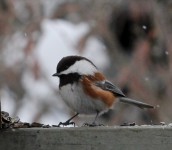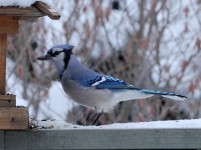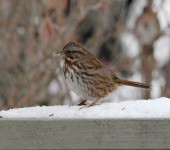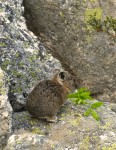One of the most loyal visitors to bird feeders are chickadees. No matter what the weather, chickadees quickly dart to a feeder, grab a seed and fly back to a safe perch. Most often the chickadees are black-capped chickadees with their familiar black cap, black bib, and gray/white body. However, other chickadees are present in North Idaho and some do visit feeders.
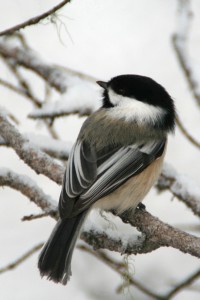
During the winter, black-capped chickadees gain ten percent of their body weight in fat each day just to shiver it off at night
All chickadees exhibit the distinctive cap and bib. Mountain chickadees are similar to the black-capped chickadees except they have a white stripe above their eyes within the black cap. Boreal chickadees sport a brown cap and an overall plumage of dark brown and gray. Chestnut-backed chickadees sport the black cap and bib but have a dark chestnut-colored back and flanks.
During cold snaps, chickadees seem to feed all day long and for good reason. Staying warm at night is no easy feat for an animal especially small animals. Black-capped chickadees seek out tight cavities to roost in at night and they fluff up their feathers. However, chickadees utilize two more measures to help them make it through the night–they lower their body temperature and shiver.
Black-capped chickadees lower their body temperature from 107 degrees Fahrenheit to 86 degrees at night to conserve vital energy reserves. They also shiver to stay warm.
Shivering consumes a fair amount of energy and to compensate for the energy needed, chickadees eat a lot during the day. Chickadees in Alaska gain 10 percent of their body weight in fat each day to burn off at night. The human equivalent is a 165-pound person losing 15 pounds by shivering all night and then eating 15 pounds the next day to do the same.
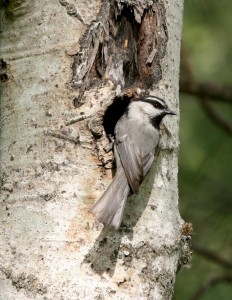
Mountain chickadees look similar to black-capped chickadees except for the white stripe above their eye
Chickadees consume a large quantity of food in winter. In the fall, chickadees cache food so they do not have to spend precious energy searching for food all the time during winter. In the winter, 50 percent of a chickadee’s diet is seeds and the remainder is frozen insects and spiders. In the summer, a chickadee’s diet shifts to 10 to 20 percent seeds and the remainder is insects, spiders and berries.
The strong legs of a chickadee allow it to hang upside down while foraging, such as when feeding on the buds at the ends of branches. This acrobatic feeding strategy is only utilized by a few other bird species.
Chickadees search the nooks and crannies of trees for spider and insect eggs and larvae, along with caterpillars. In the winter, chickadees form the nucleus of mixed flocks looking for frozen insects. The flocks can consist of chickadees, nuthatches, brown creepers, kinglets and woodpeckers. These birds aren’t typically found foraging together except in the presence of chickadees.
The chickadees will continually call to one another to keep the flock together. Another time when chickadees are extremely vocal is when they are mobbing a predator.
These faithful feeder visitors may not seem like the type to mob but chickadees are one of the most tenacious and aggressive songbirds when mobbing predators. They take the lead in announcing the presence of a small owl from a nearby perch or strike the owl from behind. Other birds may join in the mobbing to encourage the enemy to move to another area. Mobbed enemies often include small owls, squirrels, raccoons or cats.
The vocalizations of chickadees can be heard throughout the forest or as close as outside a window, whether they are mobbing a predator, keeping a flock intact or grabbing seeds from a feeder.

